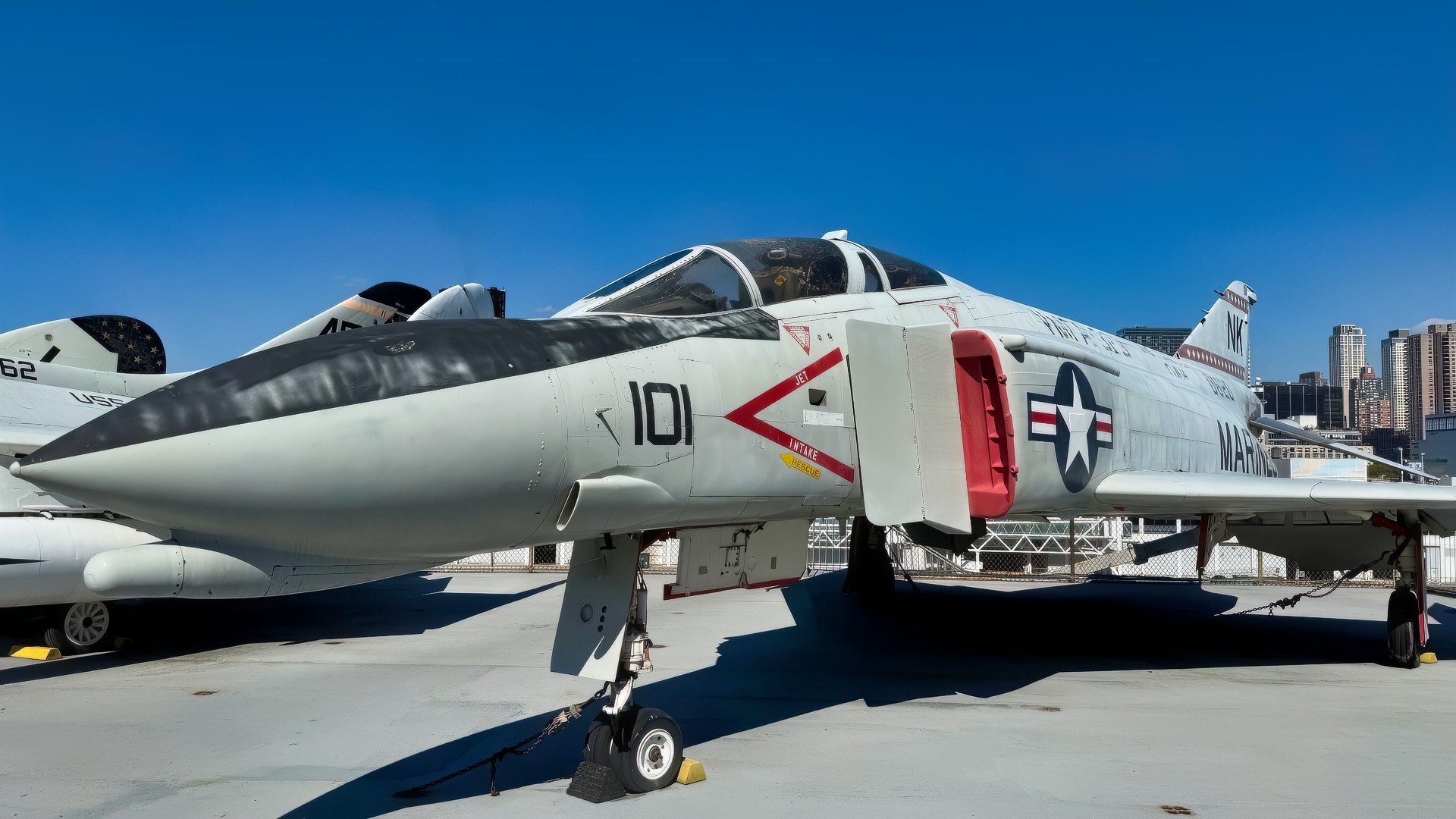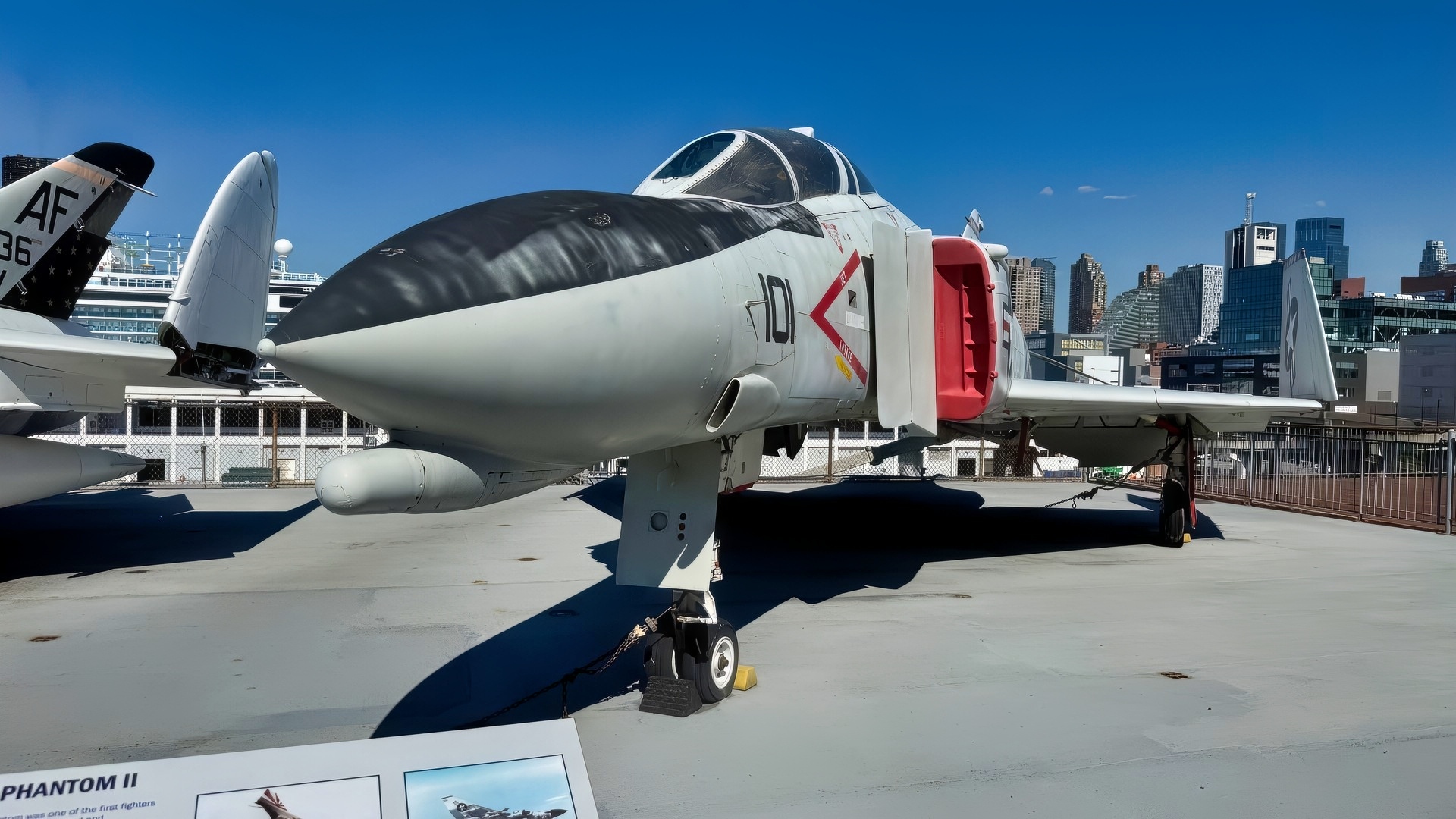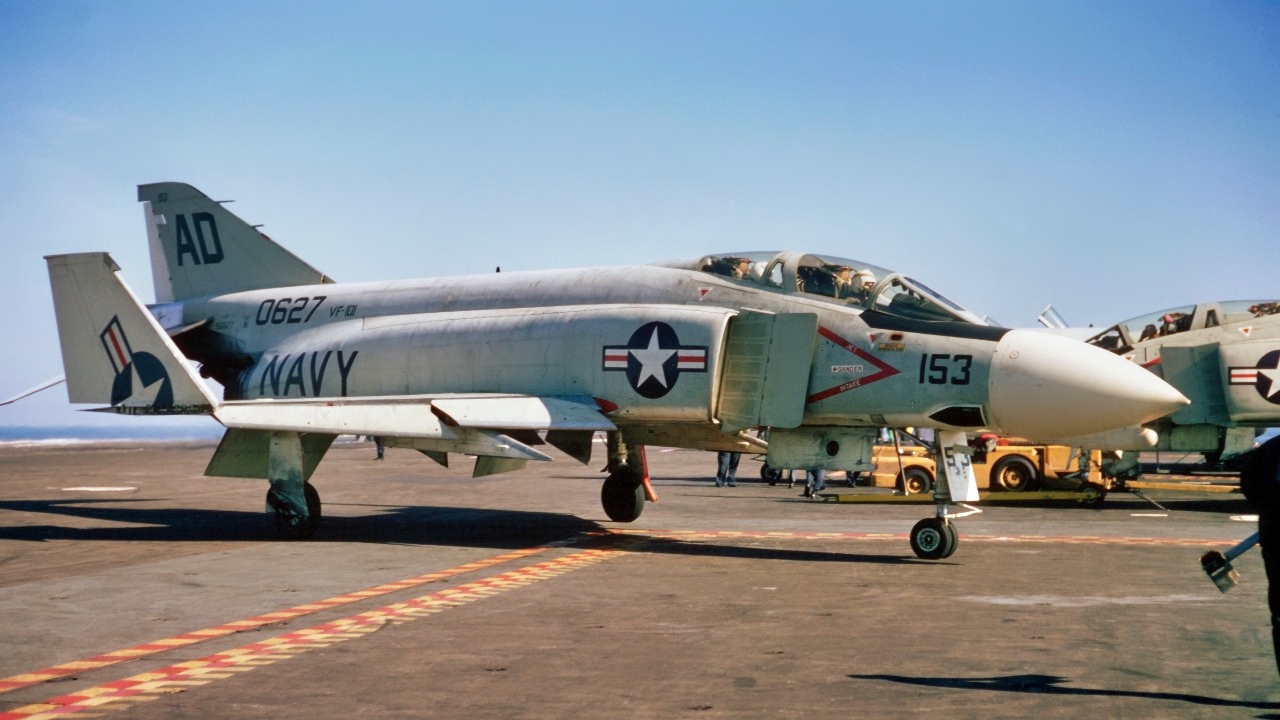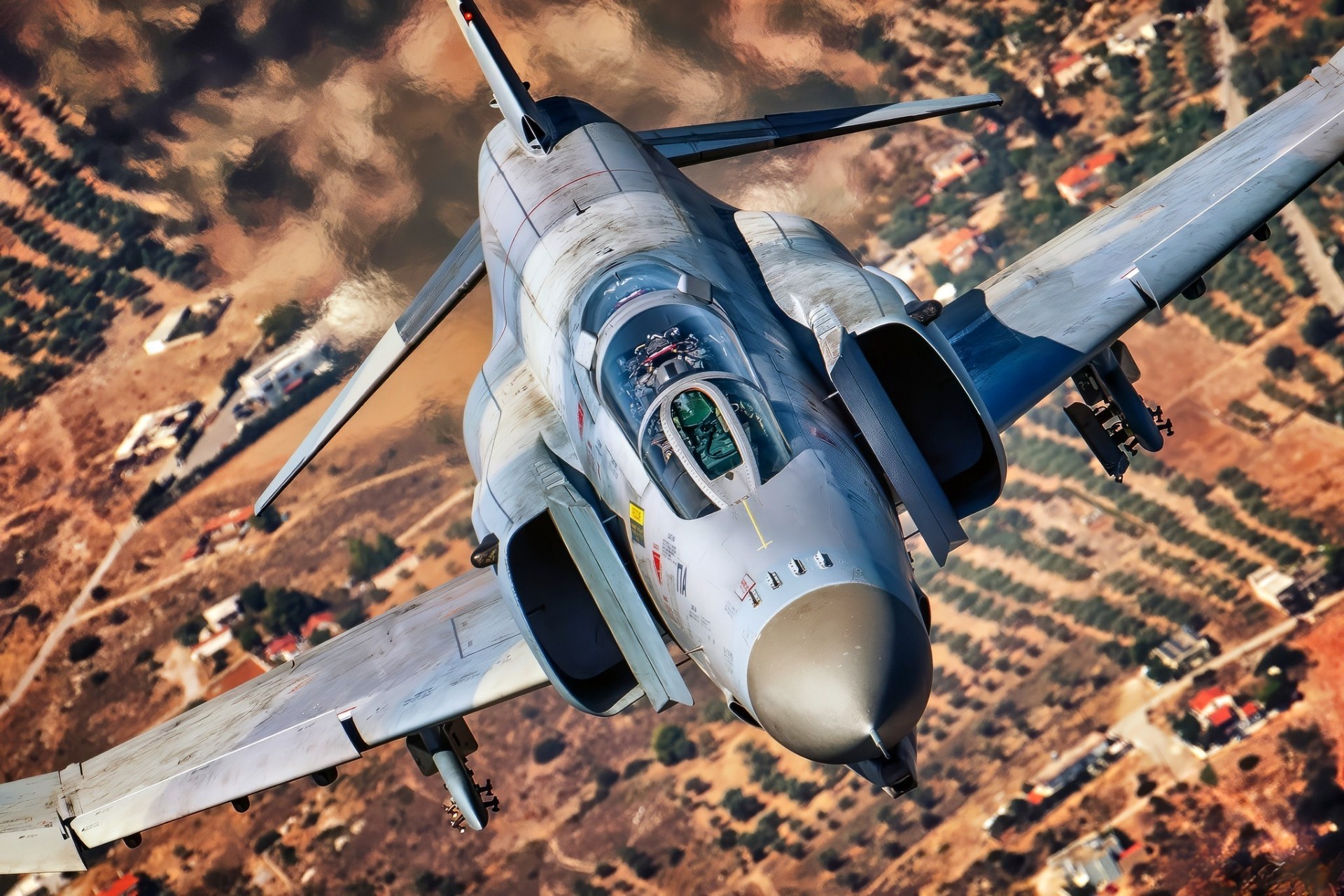Key Points and Summary – The F-4 Phantom II, a Mach 2.2 Cold War icon, was initially designed as a U.S. Navy interceptor armed only with missiles, reflecting the belief that dogfighting was obsolete.
-This assumption proved disastrous in Vietnam, where unreliable missiles and the lack of a gun led to heavy losses.

F-4 Phantom Images Original National Security Journal.
-This critical failure forced a revolution in air combat, leading to the creation of the TOPGUN school and the development of later F-4 variants with an internal M61 Vulcan cannon.
-The Phantom subsequently became the most successful U.S. fighter of the war, with 5,000 built, and its legacy of hard-won lessons shaped modern air combat doctrine.
The F-4 Phantom II Fighter Explained
The F-4 Phantom II is one of the most iconic mid-Cold War fighter jets the U.S. ever produced. Built at a time when supersonic engines were still a relatively new concept, the F-4 broke new ground and established itself as one of the most reliable and arguably most advanced fighters of its time.
The Phantom served in many theaters of combat throughout its service life, from Vietnam to the Middle East.
The aircraft achieved commercial success worldwide, including from U.S. allies in NATO and from Japan and South Korea.
With over 5,000 airframes built, the F-4 was one of the most widely produced American-made fighters during the Cold War, even surpassing the F-16.
Development of the F-4
Work on the Phantom II began in the early 1950s, a time when jet aviation was rapidly evolving and the U.S. Navy was seeking a new aircraft to replace its aging fighter fleet.
McDonnell Aircraft, which had already produced the F2H Banshee and the F3H Demon, proposed a new design that would initially serve as a carrier-based fleet defense fighter.

F-4 Phantom Photo Taken on USS Intrepid. Image Credit: National Security Journal.

F-4 Phantom II Photo from National Security Journal. Taken on September 18, 2025.
This concept was rooted in the Navy’s desire for an aircraft that could intercept enemy bombers before they reached the fleet, relying on radar-guided missiles rather than traditional dogfighting.
McDonnell’s initial proposal was a single-seat, single-engine aircraft designated the F3H-G, a heavily modified version of the Demon.
However, the Navy’s Bureau of Aeronautics (BuAer) was skeptical of the design’s limitations and encouraged McDonnell to consider a more powerful, twin-engine configuration.
This led to the development of the Model 98, which would eventually become the F-4.
Acceptance Into Service
The first flight of the Phantom took place on May 27, 1958. It quickly demonstrated remarkable performance, powered by two General Electric J79 turbojet engines that enabled it to exceed Mach 2.2.
This made it one of the fastest fighters of its time. The aircraft was equipped with advanced radar and missile systems and could carry a substantial payload, enhancing its adaptability across various mission profiles.

A Fighter Squadron 101 (VF-101) F-4J Phantom II aircraft taxis on the flight deck of the attack aircraft carrier USS AMERICA (CVA 66).
In 1960, the F-4 was officially adopted by the U.S. Navy, and shortly thereafter by the Marine Corps and the Air Force.
The Phantom’s design was distinctive, with an extended fuselage, anhedral tailplanes, and upswept wingtips.
It was crewed by a pilot and a radar intercept officer, reflecting its original role as a missile-armed interceptor.
Early models lacked an internal cannon, based on the prevailing belief that missiles would dominate future air combat.
However, combat experience, particularly in Vietnam, revealed the limitations of this approach, leading to the inclusion of an internal M61 Vulcan cannon in later variants such as the F-4E.
Combat History
The Phantom saw extensive combat during the Vietnam War, serving with all three major U.S. military branches.
It was used in a wide range of missions, including air superiority, close air support, reconnaissance, and suppression of enemy air defenses. Phantom crews engaged in numerous dogfights with North Vietnamese MiGs.
Initially, the aircraft struggled due to its lack of a gun and the limitations of early missile technology. However, as tactics evolved and training improved, especially through programs like the Navy’s TOPGUN (not to be confused with the movie), the Phantom became a formidable adversary. By the end of the war, it had achieved over 100 aerial victories, making it the most successful U.S. fighter of the conflict.
Beyond Vietnam, the Phantom played a critical role in Cold War deterrence. It was deployed across Europe and Asia, serving in NATO forces and U.S. bases worldwide.
Its ability to carry nuclear weapons made it a key component of strategic planning. The aircraft was also exported to numerous allied nations, including the United Kingdom, Germany, Japan, Israel, Iran, South Korea, Turkey, and Greece.
Each country adapted the aircraft to its own needs, and many developed indigenous upgrade programs to extend their service life.
Retirement and Legacy
The retirement of the F-4 Phantom II from U.S. service began in the 1980s, as newer aircraft like the F-15 Eagle, F-16 Fighting Falcon, and F/A-18 Hornet entered service.
The Navy retired its last Phantoms in 1986, while the Air Force continued using RF-4 reconnaissance variants into the 1990s.
The Air National Guard flew Phantoms until 1996. Even after its retirement from frontline service, the Phantom found new life as a target drone, test platform, and electronic warfare training platform.
Despite its retirement and relative obsolescence, the F-4 remains in service with a few air forces worldwide to this day.
Iran is currently the largest operator, with 62 F-4s in active service as of 2021 (this number has likely depleted since then). Greece maintains a modest fleet of around 17 fighters.
Turkey recently modernized its small fleet of F-4s, which are expected to remain in service until 2030. This underscores the reliability of Phantom, which has stayed in service for so long
Although the aircraft is long retired from the U.S., it left a major influence, particularly in shaping modern aerial combat doctrine.
Lessons learned from Phantom operations led to the development of advanced training programs such as TOPGUN and Red Flag.
These programs emphasized dogfighting skills, situational awareness, and the integration of multi-role capabilities in future fighter designs. The Phantom’s influence can be seen in the design philosophies of later aircraft, which prioritize flexibility, survivability, and advanced avionics.
About the Author: Isaac Seitz
Isaac Seitz, a Defense Columnist, graduated from Patrick Henry College’s Strategic Intelligence and National Security program. He has also studied Russian at Middlebury Language Schools and has worked as an intelligence Analyst in the private sector.
More Military
China’s New J-35 Navy Stealth Fighter Summed Up in 2 Words
China’s ‘Mighty Dragon’ J-20 Air Force Stealth Fighter Summed Up in 2 Words
China Is Trying to Turn the Indo-Pacific Into a Giant U.S. Navy ‘No-Go Zone’
$13 Billion Mistake? USS Gerald R. Ford Is the Navy’s Aircraft Carrier Agony
China’s ‘Thousands of Missiles’ Have a Message for U.S. Navy Aircraft Carriers











Roger Taylor
October 28, 2025 at 12:40 pm
Every damn article “has a message ” for someone. Tired line…
Krystal cane
October 28, 2025 at 4:38 pm
Is the message we don’t fly this anymore it’s been out of service for how many years? How many of these articles are generator by AI crap I’d say about most of them